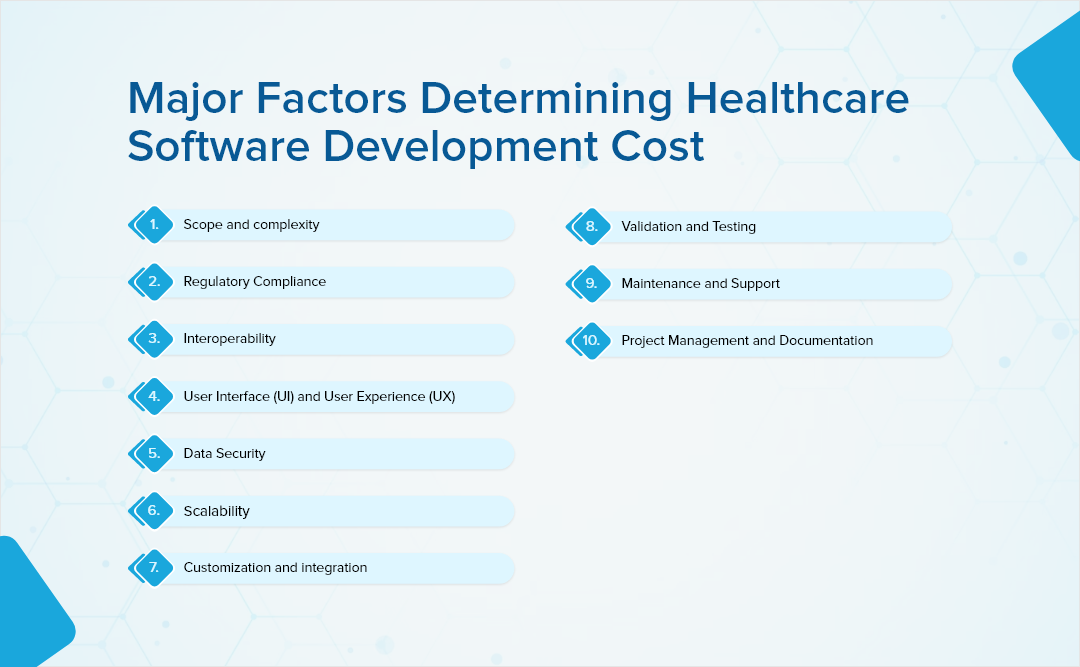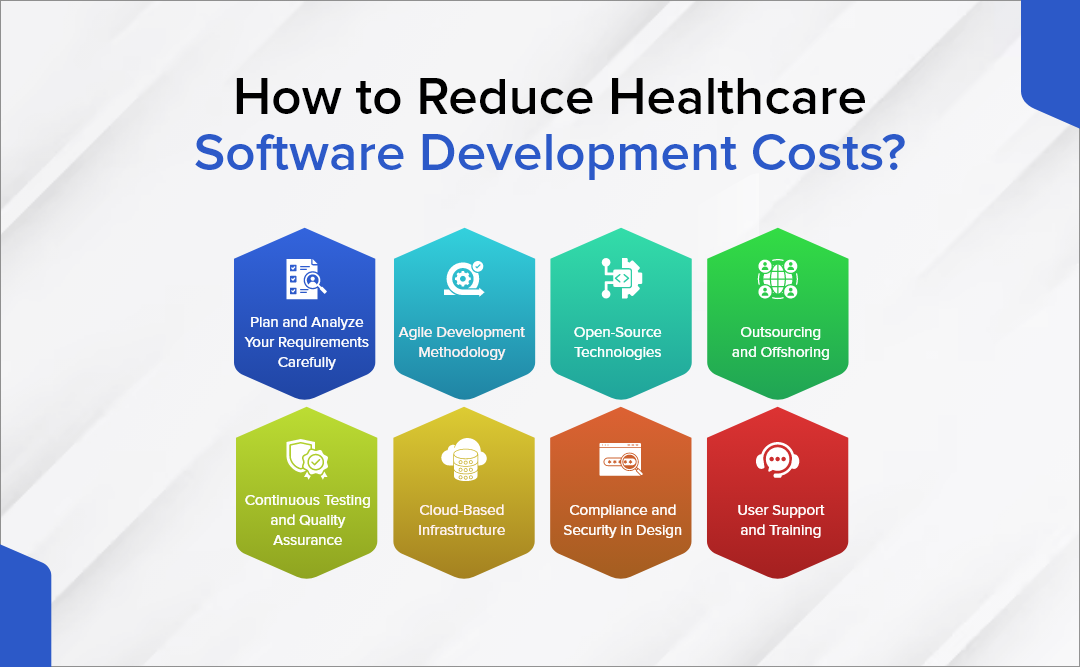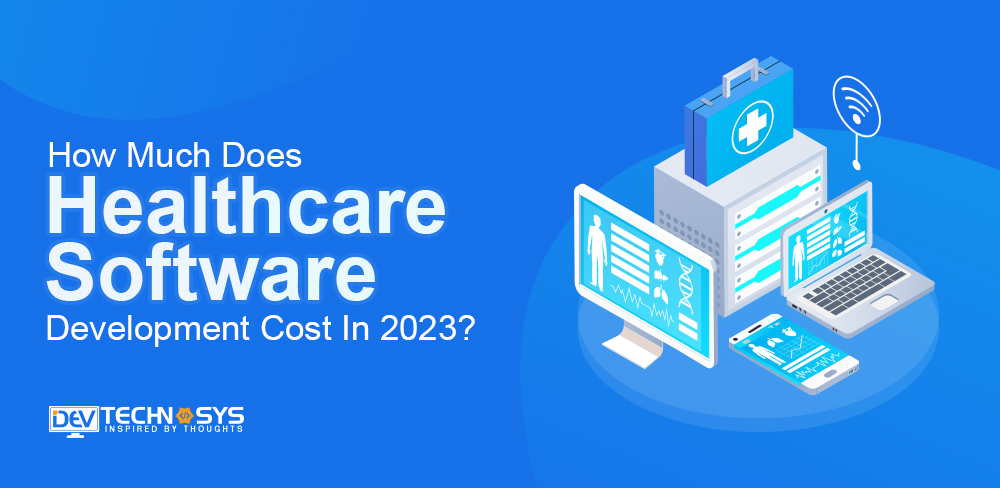Understanding the healthcare software development cost in 2023, with the healthcare landscape constantly evolving, is crucial to healthcare providers, developers, and patients. In this new year, many factors will be in play, from advancements in telemedicine and artificial intelligence to compliance and security requirements. This blog will dive deep into the complexities of healthcare software development and shed light on variables that affect costs.
We will examine the latest technologies, trends, and industry standards to provide valuable insights that can help you manage and estimate the costs associated with developing cutting-edge healthcare software solutions. Join us as we explore the healthcare software development cost in 2023. It will help you make informed decisions about your healthcare technology projects.
What is Healthcare Software Development?

The creation and maintenance of software solutions specifically tailored to the healthcare industry is known as Healthcare Software Development. These applications are intended to improve and streamline different aspects of healthcare, including patient management and electronic health records.
Custom software development services providers in healthcare strive to develop user-friendly software that is secure and compliant, allowing hospitals and medical facilities to provide high-quality care. This technology can enhance clinical workflows, improve accurate record-keeping, and support diagnostic and therapeutic processes. It also helps to increase communication between healthcare professionals.
What is The Accurate Healthcare Software Development Cost?
Healthcare software development costs are dependent on many factors, including the size, features, and complexity of an application, as well as its technological stack. Healthcare software development costs can range from $8,000 up to $30,000, depending on the type of app that is being developed.
Opting for a reputable Healthcare Software Development firm can still make the process more cost-effective. You can also hire on-demand developers to help you build healthcare software within a budget.
| Category | Cost Range |
| Planning and Design | $2,000 – $5,000 |
| Development | $10,000 – $30,000 |
| Testing and QA | $5,000 – $8,000 |
| Deployment | $3,000 – $7,000 |
| Security and Compliance | $5,000 – $8,000 |
| Maintenance and Support | $5,000 – $10,000 |
| Marketing and Launch | $10,000 – $15,000 |
The table below summarizes the healthcare software development cost. With this budgetary insight in hand, you can now plan your medical fitness app like DHA, accordingly.
Major Factors Determining Healthcare Software Development Cost
A number of factors can influence the healthcare software development cost. These factors can have a significant impact on the timeline and budget of a software project. This section will examine 10 factors that influence the healthcare software development cost.

1. Scope and Complexity
The scope and complexity of a healthcare software solution primarily determine costs. The development of complex systems that include advanced features such as electronic health records (EHR), AI-driven diagnosis, telemedicine, or AI will take more time and resources. To manage costs effectively, it is important to have a clear project scope and requirements.
2. Regulatory Compliance
Software for healthcare must adhere to strict regulations, such as HIPAA in the United States and GDPR in Europe. Complying with rules adds complexity to healthcare software development costs. It is because it requires data security measures, audit trails, and encryption to protect patient information.
3. Interoperability
Software for healthcare often has to be integrated with existing systems such as EHRs or laboratory information systems. Interoperability is a challenge, as it requires the creation of custom APIs and user interfaces. It can lead to increased healthcare software like Kareo costs.
4. User Interface (UI) and User Experience (UX).
In order to make healthcare software more efficient, medical professionals must have a positive experience. It can be expensive to design and implement intuitive UI/UX functions since it requires user research, usability tests, and iterative improvements.
5. Data Security
Healthcare software must protect sensitive patient data. To prevent data breaches, robust security measures, including encryption, access control, and regular audits, are required. These measures increase healthcare software development rates but are crucial to maintaining trust.
6. Scalability
Software for healthcare must be scalable in order to handle the increasing volume of data and users. A scalable architecture that uses cloud-based solutions, load balancing, and other mechanisms to increase the initial cost of building healthcare software can save money over time as the system will grow along with the needs of the organization.
7. Customization and Integration
Adapting software to the specific workflows and processes of healthcare providers is a common requirement. These customizations are often time-consuming and expensive. Integration of third-party services and tools, such as billing software and diagnostic tools, can also add complexity and cost to a project.
8. Validation and Testing
In order to ensure regulatory compliance and patient safety, healthcare software must be rigorously tested and validated. Included in this are unit testing, validation against industry standards, and integration testing. This extensive testing can increase healthcare software development costs and time
9. Maintenance and Support
Software for healthcare requires regular maintenance and support in order to fix bugs, address security vulnerabilities, and keep up with regulatory changes. Maintenance costs should be included in the project budget as they are essential to the long-term viability of app like WalkFit.
10. Project Management and Documentation
For the development of healthcare software, it is essential to have a good project management system, documentation, and communication. These include project planning, reporting, tracking, and reporting, as well as detailed documentation for future reference and compliance. These activities may not directly affect software features, but they are vital for project success. They can also impact healthcare software development costs.
How to Save Healthcare Software Development Costs? 7 Monetization Techniques
Software development for healthcare is vital to improving patient care and streamlining operations. It also enhances the overall experience of patients. It can be expensive to develop software. This section will explore seven monetization methods to help you recover your healthcare software development cost and generate revenue. These strategies will help you optimize your budget, achieve financial sustainability, and deliver valuable healthcare solutions.

1. Subscription Models
Subscription models are a great way to monetize software for healthcare. Subscription plans can be categorized according to their features to meet the needs of different users. Subscriptions are a reliable revenue stream that makes it easier to recover the cost of healthcare software. You should constantly improve the software in order to attract and retain new subscribers. Consider offering free trials and freemium versions as well to encourage users to upgrade to premium plans.
2. Licensing Fees and Royalties
Consider licensing your software to other healthcare providers or companies in the healthcare industry. You can earn revenue by charging licensing fees or royalties to use your software. Protect your intellectual property with copyrights and patents to receive the proper compensation.
3. Telemedicine and Consultation Fees
Integrate telemedicine into your software to allow healthcare providers remote consultations. These virtual appointments can be charged for, generating revenue and providing convenience. This strategy is a win-win for both patients and providers, as it reduces travel healthcare software development costs and increases accessibility.
4. Data Analytics and Insights
Use the data collected by healthcare software to offer valuable analytics and insights to healthcare organizations. These insights can be used to improve patient care, optimize operational efficiency, and help make informed decisions. You can charge for these data analytics services to create a revenue stream and provide actionable information to clients.
5. Partnerships and Integrations
Form partnerships with other healthcare providers such as medical device manufacturers or healthcare service providers. Integrating your software with complementary products will allow you to offer your users enhanced functionality. You can also negotiate revenue-sharing agreements or referral fees. These partnerships may also provide cost-sharing, which can reduce your overall cost of custom software development.
6. Sponsored Content and Advertisements
Although not the most popular approach for healthcare software, carefully selected sponsored content and advertising can generate revenue. Consider partnering with healthcare publications, medical device companies, or pharmaceutical companies to create relevant, non-intrusive content. To maintain the integrity and trust of your software, you should not compromise user privacy or trust.
7. Research Grants and Collaborations
Collaboration with government agencies, research institutions, and universities on healthcare research is a great way to get funding. These collaborations may lead to funding and grant opportunities for software development. Research grants cover the healthcare software development cost, which allows you to sell your product at a lower price or for free.
How to Reduce Healthcare Software Development Costs?
The development of healthcare software is crucial to improving patient care and streamlining operations. It also enhances the efficiency of healthcare organizations. Healthcare software development costs can be expensive due to regulatory compliance, the security of data, and the complexity of healthcare systems. Organizations must use efficient strategies to reduce healthcare software development costs without compromising safety and quality. We will examine eight strategies that can help to reduce the healthcare software development cost.

1. Plan and Analyze Your Requirements Carefully
Inadequate requirement analysis and planning is a major cause of cost overruns during software development. It is important to involve stakeholders in the requirements-gathering process for healthcare software, such as healthcare professionals, administrators, and end users. Well-defined and detailed requirements can help avoid costly scope changes in development. This phase is where you can reduce your overall healthcare software development budget by investing time and effort.
2. Agile Development Methodology
By improving transparency, flexibility, and collaboration, adopting Agile development methodologies, such as Scrum, Kanban, or Kanban, can help reduce the cost of developing software. Agile encourages iterative, rapid development. It allows for frequent review and adjustments in response to changing requirements. It reduces the chance of creating features that aren’t needed and can lead to significant savings.
3. Open-Source Technologies
Open-source frameworks and technologies can reduce the cost of developing healthcare software. Open-source solutions provide libraries, tools, and platforms that are robust and maintained. This can speed up development and reduce the requirement for custom-built parts. Open-source solutions must be carefully evaluated to ensure that they meet compliance and security requirements.
4. Outsourcing and Offshoring
Offshoring or outsourcing certain aspects of software development for healthcare can be an effective strategy. Hire dedicated developers with experience and located in countries where labor costs are lower, organizations can cut expenses without sacrificing quality. To ensure success, however, it is important to select a reputable partner and establish clear communication and management processes.
5. Continuous Testing and Quality Assurance
Failure to identify and resolve issues early on in the development process may lead to delays and costly rework. Continuous testing and quality assurance can reduce the costs of later fixing defects by catching them early. Test-driven Development (TDD) and automated testing tools can help streamline this process. This will improve software quality while minimizing healthcare software development costs.
6. Cloud-Based Infrastructure
It can be costly to maintain and set up traditional on-premises infrastructure, particularly for healthcare software that has high availability and scaling requirements. Cloud-based infrastructure such as Amazon Web Services, Microsoft Azure, or Google Cloud Platform can reduce infrastructure costs and eliminate the need for large initial investments. It also allows you to scale resources according to your needs.
7. Compliance and Security in Design
Software for healthcare must comply with strict regulations, including the Health Insurance Portability and Accountability Act in the United States. By building compliance and security into software at the start, you can avoid costly retrofits as well as legal issues. To prevent expensive breaches, the healthcare software development company must follow and understand best practices in data security and privacy.
8. User Support and Training
After the software has been deployed, user support and training are essential to ensure its success. Inadequate user training can result in inefficiencies and mistakes, which are costly both in terms of time and patient care. By investing in training programs that are comprehensive and have responsive support channels, users can learn faster and avoid costly mistakes.
Takeaway!
Healthcare software development costs will vary significantly in 2023, depending on the complexity and features of the project. Basic healthcare app development pricing varies from $8,000 to $20,000, while more complex systems with many features can exceed $30,000. Consider factors such as the expertise of your development team, your technology stack, compliance with regulatory requirements, and ongoing maintenance to determine how much you will pay. Budgeting is important because investing in quality healthcare software can have a significant impact on patient care and efficiency.
Frequently Asked Questions
1. What factors will influence the healthcare software development cost in 2023?
Project complexity, features, and technology stack are all important factors.
2. What will the cost of a basic software application for healthcare be in 2023
Basic healthcare apps range in price from $8,000 up to $25,000.
3. What will it cost to develop a complex healthcare system with many features in 2023?
The development cost of complex systems can be as high as $25,000.
4. Why it is important to budget carefully for the development of healthcare software in 2023
Budget planning is essential to ensuring high-quality software and improving operational efficiency.
5. What are the major cost drivers for healthcare software development by 2023?
The key cost drivers are functionality, data protection, compliance, and ongoing support and updates.














